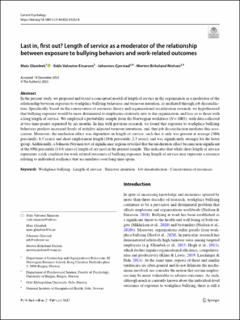| dc.contributor.author | Glambek, Mats | |
| dc.contributor.author | Einarsen, Ståle Valvatne | |
| dc.contributor.author | Gjerstad, Johannes | |
| dc.contributor.author | Nielsen, Morten Birkeland | |
| dc.date.accessioned | 2023-12-22T09:24:55Z | |
| dc.date.available | 2023-12-22T09:24:55Z | |
| dc.date.created | 2023-02-22T09:04:12Z | |
| dc.date.issued | 2023 | |
| dc.identifier.citation | Current Psychology. 2023, . | |
| dc.identifier.issn | 1046-1310 | |
| dc.identifier.uri | https://hdl.handle.net/11250/3108741 | |
| dc.description.abstract | In the present study, we proposed and tested a conceptual model of length of service in the organization as a moderator of the relationship between exposure to workplace bullying behaviors and turnover intention, as mediated through job dissatisfaction. Specifically, based on the conservation of resources theory and organizational socialization research, we hypothesized that bullying exposure would be more detrimental to employees relatively new to the organization, and less so to those with a long length of service. We employed a probability sample from the Norwegian workforce (N = 1003), with data collected at two time-points separated by six months. In line with previous research, we found that exposure to workplace bullying behaviors predicts increased levels of stability-adjusted turnover intentions, and, that job dissatisfaction mediates this association. Moreover, the mediation effect was dependent on length of service, such that it only was present at average (50th percentile; 8.5 years) and short employment length (16th percentile; 2.5 years), and was significantly stronger for the latter group. Additionally, a Johnson-Neyman test of significance regions revealed that the moderation effect became non-significant at the 69th percentile (14.6 years of length of service) in the present sample. This indicates that while short length of service represents a risk condition for work-related outcomes of bullying exposure, long length of service may represent a resource relating to individual resilience that accumulates over long time-spans. | |
| dc.language.iso | eng | |
| dc.title | Last in, first out? Length of service as a moderator of the relationship between exposure to bullying behaviors and work-related outcomes | |
| dc.title.alternative | Last in, first out? Length of service as a moderator of the relationship between exposure to bullying behaviors and work-related outcomes | |
| dc.type | Peer reviewed | |
| dc.type | Journal article | |
| dc.description.version | publishedVersion | |
| dc.source.pagenumber | 13 | |
| dc.source.journal | Current Psychology | |
| dc.identifier.doi | 10.1007/s12144-022-04202-8 | |
| dc.identifier.cristin | 2128070 | |
| cristin.ispublished | true | |
| cristin.fulltext | original | |
| cristin.qualitycode | 1 | |
